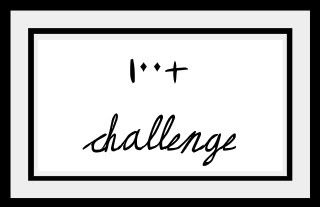
XVI
Julia Karr

rating: 8.5 out of 10 "books"
“Some girls can’t wait to be sixteen, to be legal. Nina is not one of them. Even though she has no choice in the matter, she knows that so long as her life continues as normal, everything will be okay. Then, with one brutal strike, Nina’s normal is shattered; and she discovers that nothing that she once believed about her life is true. But there’s one boy who can help—and he just may hold the key to her past. But with the line between attraction and danger as thin as a whisper, one thing is for sure… for Nina, turning sixteen promises to be anything but sweet.” – Back cover, XVI
As the back cover of Julia Karr’s XVI states, Nina is not thrilled with the idea of turning sixteen. In this futuristic dystopian novel where the Governing Council and the Media controls everything and citizens are bombarded with noise from advertisements and the like 24/7, sixteen is a very important age for females. Sixteen for a girl indicates adulthood, and the legal age for girls to have intimate relations with men. Schools show videos that instruct girls on how to make men happy and “verts,” (advertisements) tell girls, “how popular they’ll be if they dress and act so boys will want to have sex with them” – page 277. However, as exciting as that sounds for girls like Nina’s friend, Sandy, who’s been studying up on XVI Ways learning about what guys like in a “sex-teen” (as sixteen year olds are referred to), Nina knows turning sixteen is more dangerous than liberating. Because at sixteen, girls are required to get a large XVI tattooed on their wrists, and most guys see that as fair game to do whatever with girls and in many cases, without their consent.
Nina and Sandy are considered lower tiered girls. In this version of the future, money is referred to as “credits,” and those with it are considered a tier 10 or higher. The government provides for everyone even those who have no money as long as they agree to government experiments. Nina and Sandy are at a tier 2, and for girls like them there are not many options. Nina can either hope to earn status as a Creative with her artwork, marry an upper tier guy, or enroll in the mandatory FeLS (Female Liaison) program that all lower tiered girls are required to sign up for. Sandy can’t wait to enroll in and hopefully be chosen for FeLS, and escape her lower status, but Nina has reservations as to what the program is actually about. Whereas Sandy’s mom encourages her daughter’s sixteen ways, Nina’s mom instructs her daughter on the dangers of life at sixteen. With Nina’s dad deceased, Ginnie is the only parent Nina has left.
Nina’s life is going ok until major events change everything. With the seemingly impossible prospect of her father being alive, and the threat of her mother’s boyfriend coming after her at every turn, Nina enrolls the help of her friends to discover the truth behind the Governing Council, the Media, and the FeLS program before it’s too late
I thought this was a really great case study if you will, as to what could happen if society really took media portrayals seriously. Karr writes in an interview at the end of the book about how “there is a huge disconnect between the vestiges of our country’s underlying Puritan mind-set regarding sex and the business of selling teen sexuality through media.” It’s already enough that society itself sends girls one message on how to look and act with regards to sexuality; and movies, television, and magazines send girls a completely different message.
I did feel the back cover of this book was somewhat detrimental to the point of XVI. I know that the author did not write it, but whoever included the part that says, “There’s one boy who can help,” kind of missed the point. I saw this book as trying to show Nina as a strong female character, who yeah is dealing with typical teenage hormones but, who doesn’t need a prince charming to save her. To include that line on the back cover kind of drops the book down from “independent woman” theme of the story back to the typical “weak damsel in distress in need of rescuing from a man,” portrayal of women.
The only other major problem that I had with this book was how Karr wrote about sixteen year old girls as if becoming sixteen was like contracting a disease that made girls only want to have sex with every guy in sight. I know that this was the message the girls in this book were getting from the Media, and that was just bleeding through onto the pages when the female characters were thinking or speaking, but it got annoying after awhile. With Sandy basically saying things like “you won’t be able to think about anything else besides sex once you turn sixteen,” I started getting really mad. Especially since this didn’t seem to be the case at all for any of the guys in the story. The author never really included any dialogue that showed how Nina’s guy friends felt about the girls becoming sex-teens, or how they felt about sex at all. It seemed like the guys were the level-headed characters of the story, especially the character of Sal. Nina and Sal would be making out and Nina would be freaking out with thoughts of “oh I’m no better than a sex-teen with my intimate thoughts and wanting to do more with Sal,” while Sal seemed to be all smooth talking and in control, with no resemblance of the typical horny sex-obsessed teenage boy most of us are familiar with.
I really enjoy stories that look at an extreme version of our future if current global practices continue; whether environmentally, socially, politically, etc. If you like dystopian books, or books that portray a very realistic future, I’d recommend (both guys and girls) checking out XVI. In a world where kids can’t wait to grow up, it’s refreshing to read a cautionary story about wanting too much too soon. Although the book mentions sex a lot, XVI is more about the dangers of teenage relations and attitudes towards it, as opposed to an endorsement. Nothing obscene happens, so parents of teenagers rest easy.


















Looks good! I'll check it out.
ReplyDelete